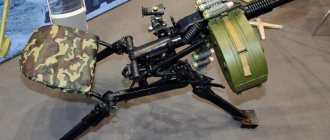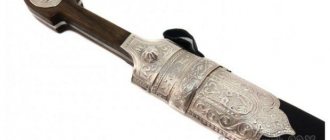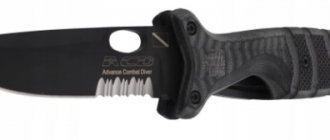Throughout its history, humanity has created many types of piercing and cutting bladed weapons. In European countries, the most ancient version of combat knives is considered to be a dagger. Craftsmen made several varieties of this short-bladed weapon.
One of the most effective examples of European combat knives is the Daga dagger for the left hand. The history and description of this blade are presented in the article.
Description
The “Daga” dagger is a bladed weapon, which has a short narrow blade, very similar in appearance to a stiletto, and a complex guard. It is presented in two options: in the form of a bowl or arches. The hilt has a wide guard and a crosspiece, the ends of which are curved forward. “Daga” is equipped with a special catching device in the form of a steel plate with ends curved towards the tip.
It is installed between the handle and the blade. Thanks to such design features, the Daga dagger is highly effective in capturing and holding an enemy’s blade. The guard shield has the shape of an openwork triangle. The blade can be flat or equipped with 3-4 edges. The width is 10 mm. According to experts, faceted blades are more effective than flat ones, since they can pierce chain mail.
Some daggers have no cutting edge at all. At one time, such “Dags” were used only for piercing blows. This type of dagger is characterized by a small cross-section, due to which the edged weapon is highly durable. In addition, the blade is completely steel. The size of the Daga dagger (photo of the weapon is presented in the article) is 500-600 mm. Of this, the blade itself accounts for 300 mm. This product weighs no more than 0.5 kg.
Kirpan
Sikhism is one of the world's largest religions, which arose among Hinduism and Islam. She preaches love and brotherly relations to all people on earth, regardless of their origin. A devout Sikh is first and foremost a good person, independent and respectful of the freedom and religion of others.
According to the official code of conduct, Sikhs are required to keep five items (five Ks) with them - kesha - hair hidden under a turban, kangsha - hair comb, kara - steel bracelet, kachla - underwear and kirpan - a sword or dagger hidden under clothing. The rule of always carrying a dagger, introduced by the tenth guru of Sikhism, Gobind Singh in 1699, must be strictly followed. At the same time, the kirpan must be worn in a sheath and in no case should it be used in anger, for a malicious attack or to assert one’s power. The important place of edged weapons in the life of every Sikh man is also evidenced by the fact that the most significant symbol of this religion - the khanda - is a crossed kirpan.
Literally, kirpan is translated as “weapon of defense” (kirpa - “mercy” and aan - “blessing”) and is contrasted with talwar - “weapon of crime (insult),” the traditional curved Indian sword. There is also another translation option: from Punjabi keer pahn means “hand of mercy,” which, however, does not change the meaning.
The symbol of Sikhism - the khanda - consists of two crossed kirpans, in the center there is a double-edged sword and a chakra throwing disc.
Despite the peaceful name, the kirpan has a distinctly aggressive design of a typical oriental shape. A curved blade, often forged from iron or mild steel, ranging from 7.5 to 90 cm in length, excellent for slashing, cutting and thrusting. Sikh gurus, preaching universal love, nevertheless invented the martial art of gatka, which also includes characteristic circular cutting techniques with kirpan.
Like any military weapon, the kirpan is not allowed to be worn everywhere: 10 million stern-looking Sikh men scattered around the world, each of whom, although he preaches peace and brotherhood, but according to the requirements of his faith, has weapons, still inspires fear. In India, wearing a kirpan is permitted under special Article No. 25 of the Indian Constitution.
As a rule, the kirpan is worn on a separate hanging belt, slung over the shoulder or attached to the belt
In Sweden and Denmark, a devout Sikh can carry a kirpan only in the form of a pocket (pen), household or professional (for example, carpenter) knife, which does not offend the feelings of believers, because the Sikh code does not stipulate the detailed type of dagger.
In the US state of California, legislators require that the blade of the kirpan be dulled and fixed in a sheath, which makes it impossible to use as a weapon, but retains its status as a symbol of faith.
The pendant for the kirpan can be an ordinary leather belt or, as in this case, a skillfully woven belt
Sikhism
Sikhism (derived from the Punjabi word "sikh" - "follower, disciple") is a religion founded in Punjab, in the northwestern part of India on the border with Pakistan.
Its founder is Guru Nanak (1469-1539). By 1990, the Sikh religious community (panth) numbered about 16 million people, 14 million of whom lived in the Indian states of Punjab and Haryana. At the beginning of the 20th century. The famous Swiss company Victorinox released a batch of traditional kirpans in honor of the 400th anniversary of the holy Sikh book “Adi Granth”.
Share link
About combat use
The use of dag gave impetus to the emergence of new fencing techniques, in which the victory was won not by the strongest, but by the more dexterous and faster fighter. Each country had its own school. The Germans specialized in performing slashing blows, the Italians - piercing blows. Despite the fact that each school had its own handwriting, they were taught to reflect blows only with the left hand. During training, we used bucklers - special fist shields. In battle conditions, in the absence of a daga, the student could use a cloak wrapped around his hand.
At the beginning of the 16th century, the Spaniards invented a new style of sword fighting, which was called “Espada and Daga.” Attacking blows (lunges) were made with a sword, which the fencer took in his right hand. “Daga” was held in the left. The purpose of the dagger is to parry enemy blows. Using a sword and a daga, a fencer could effectively perform double strikes with two blades, defend and attack at the same time.
The dagger replaced the heavy shield. According to experts, with a daga you can not only parry enemy blows, but also attack, which was impossible to do with a shield. Swords often broke during fights. In such situations, the functions of the main weapon were performed by the dags. The dagger was very effective only at short range. During the fight, the tip of the daga was directed towards the enemy. The dagger was held at neck or chest level. According to experts, fencers never held this weapon with a reverse grip. The use of daggers allowed the fighter to move freely and perform complex piercing and cutting blows.
Predecessor of Daga
There is no secret here - this is a quilon dagger, the “little brother” of the knight’s sword. It appeared in the 13th century, and reached the peak of its development in the 15th century, when from a weapon common in various strata of society it became purely knightly. Noble.
Late Quilon
The fact is that it was initially fashionable to make these weapons en suite
– in the same style, “at the same time” with the sword. The finishing of the hilt of such a dagger copied the finishing of the sword hilt. And the pommel was the same, and the quillons, i.e. crosshairs, and even the geometry of the blade was tried to be brought closer to the geometry of the sword - as far as possible. The quilon was most often worn on the belt on the right, in a position adapted for snatching with the right hand with a reverse grip. European knights preferred it for a dagger in 80% of cases - it was easier to inflict a deep wound on an enemy dressed in at least a durable quilted gambeson.
Engraving from Maciejewski's Bible
Note the warrior in the yellow cape in the right corner
Around the middle of the 15th century, civilian double-armed fencing began to take shape, where the shield, inconvenient in everyday use, was replaced with a dagger. Let me clarify: we are talking specifically about civilian, dueling “shaming”, not about combat. A shield is a bulky and inconvenient thing, constantly carrying it with you is a big hassle... Why not replace it with a dagger, which almost every swordsman of those years still had hanging from his belt?
This is how the quillon became a left-handed dagger.
Its fate was determined by the fact that only this dagger, of all the European ones, had a developed guard with a long guard - this is important! – forward-facing quillons – crosshair bars. Yes, it was because of them that it got its modern name
What is curious is that the manner of wearing such a dagger did not necessarily imply that it was suitable for being drawn with the left hand. Very often it was worn behind the back, at the level of the waist, with the handle to the right. In this position, it did not interfere with walking, and if necessary, it could be grabbed with its right hand to reflect the blow. And only then did he transfer to the left.
"Bugloss"
The place where this dagger “Daga” was made was Venice and Verona. The weapon is equipped with a short, wide and flat symmetrical blade. A triangular and triangular tip is formed by converging straight lines of blades. In some daggers of this type, the blades may be separated by an edge. The handle consists of bone or wooden plates. The place of their attachment was a flat rod, in which a tube expanding upward forms the head of the dagger.
In some variants of edged weapons, the tube can be crimped on the sides with a metal strip, the ends of which extend to the beginning of the handle. The arms directed towards the tip are also covered by a strip, like the tube itself. The location of their installation was the base of the blade. The arms are attached by riveting. The overall size of the dagger can vary between 600-700 mm.
Dagassa
It is a Western European piercing bladed weapon - a wide dagger or combat knife. Italy is considered the birthplace of these products. They became especially widespread in the XIV-XVI centuries. “Daga” consists of a straight, double-edged, spear-shaped blade. Special edges are provided for the side planes of the knife, due to which the daggers are very effective in piercing armor. For comfortable holding of the weapon, the base of the blade is equipped with special grooves for the thumb and index finger. They are protected by arms that descend towards the blade.
About German weapons
The design of the German dagger consists of a main blade and two side blades that move apart. They are provided with a hinged mount. The mechanism for retracting them is driven by a special spring. After pressing the corresponding button, the weapon takes on the appearance of a kind of trident.
This design feature made it possible for a fencer to break the blades of his opponents during a fight. To do this, it was enough to trap the blade of an enemy knife and press the bolt button on the handle of the daga. Then the grips of the side blades were released, after which they were released and, spreading to the sides, broke the blade.
About the Spanish model
The Spanish version of daga is considered the most famous. The dagger is characterized by the presence of a flat, narrow blade and a developed guard. A blade with a wide base, tapering towards the tip. Spanish daggers have a one-sided sharpening. The dagger's guard consists of long straight arches and a triangular shield that goes around the hand.
Its purpose is to protect the fencer’s hand from enemy blows. At the base of the blade, the shield is wide and narrowed at the pommel of the handle, which in the Spanish “Dagas” are mostly short. The pieces are usually equipped with expensively decorated hilts.
The first dugs
The first left-handed daggers differed from their “father”, perhaps, only in the blade, which tended to be slightly leaf-shaped (they were wide, with a smooth narrowing towards the tip), always with long and forward-directed crosshairs, as well as a side ring on the guard. This type of dagger began to spread around 1550.
Blades began to become powerful, because... the sword at this time still retained the ability to cut, and a thinner blade could simply break. Here, for example, is a rapier and dagger from around the 1570s, made en suite:
T.N. dueling headset
In other cases, a left-handed dagger received an S-shaped guard - the upper quillon is directed forward so that the owner can try to catch the enemy sword between it and the blade, and the lower one is directed back, forming a half-arc to protect the hand:
Another paired set from around the same time
The hilts of left-handed daggers, just like swords, were always made of steel. The time for copper and brass hilts, fashionable in the 18th-19th centuries even for swords and sabers, has not yet come. The daga of that time, despite all its grace and beauty, was a military weapon. Its hilt was supposed to save the owner’s hand - in critical cases, withstanding the chopping blow of the sword.
The 16th-century daga cross-section was usually a slightly flattened diamond. Sometimes there was a narrow fuller the entire length of the blade. Subsequently, to improve balance, holes began to be made in the blades, mainly located at the guard.
About the Japanese version
The sai dagger is equipped with a narrow round or multifaceted blade, along which the guard arms stretch towards the tip. Unlike European versions, these arms are sharpened. Also, the Japanese sai differs from other dagas in that it is not an additional melee weapon. Moreover, this dagger does not belong to samurai combat blades. The sai is an agricultural tool. According to experts, the jutte is considered a real Japanese combat blade.
Structurally, it is very similar to the sai, but the combat version is equipped with only one bow and a powerful, thick, faceted and unsharpened blade. Also, the jutte does not have a tip, which is why this product was used as a police baton. Since the Japanese police force in the Edo era included samurai, historians say the jutte can be classified as a samurai weapon. It was not used in conjunction with another blade. Unlike European dagas, the police baton was not intended to kill the enemy.
With the help of jutte they only disarmed intruders armed with swords. Japanese craftsmen also made a jutte with a sharply sharpened blade. This type of bladed weapon was called “marokhosi”. The police were not equipped with such a blade.
Varieties of dag[edit]
Image of Spanish (Fig. 1) and German (Fig. 2) dag from the encyclopedic dictionary of Brockhaus and Efron (1890-1907)
Spanish dagaedit
To protect the hand, the Spanish daga has a wide plate in the form of a curved triangle, tapering towards the top of the handle (Spanish: en berceau
), often decorated with embossing.
The long straight arms of the guard are used to repel blows. The blade is flat, straight, single-edged, with a wide base (Spanish: ricasso
).
German dagaedit
The German daga has a trap for the enemy blade in the form of side blades diverging to the sides, driven by a special spring. It consists of two parts pivotally connected to the main blade, which are tilted to the sides by springs. The grips were released by pressing the handle lock button. If the enemy’s sword hit the trident thus obtained, the tip of the blade could break.
Japanese dagaedit
The Okinawan daga (sai) has a narrow round or multifaceted blade. The guard is a narrow bow directed forward in the direction of the blade. Unlike the European daga, it was not an addition to fencing weapons. The sai was not a samurai weapon at all - it was an agricultural tool. Moreover, the weapon was practically unknown in Japan, but was widely distributed in the Japanese vassal kingdom of Ryukyu. Also, the curved edges of the sai, in turn, being sharpened, formed additional blades, which was not observed in European dag guards.
The real Japanese daga is the jutte, which is similar to the sai, but has only one bow and a powerful thick faceted blade without sharpening or an edge, since the jutte was used as a sword and as a police baton. Since the Edo era police consisted of samurai, we can say that the jutte is, although very specific, still a samurai weapon. Being a police weapon for disarming a criminal armed with a sword and capturing him alive, unlike the European daga, the duztte, as a rule, was not used in conjunction with a sword. There was also a sharpened version of the jutte with a real sharpened blade - marohoshi, which for obvious reasons was not a police weapon.





